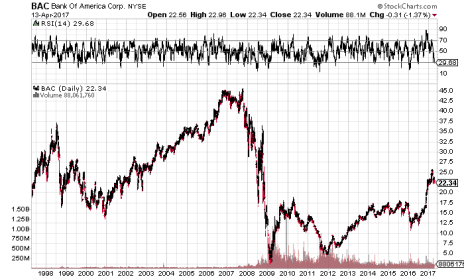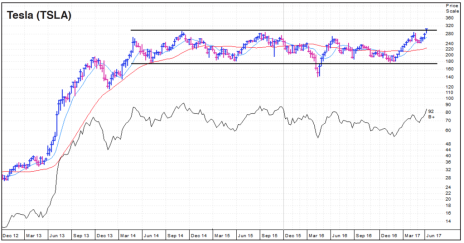Tesla (TSLA) has been on a tear of late, which has some investors asking whether it might be time to sell TSLA stock. I’ll get to that in a bit. But first, I want to talk about a far less exciting stock, Bank of America (BAC).
Getting Out of Your Comfort Zone
At last year’s Cabot Wealth Summit, I was presiding over a table where participants discussed stocks they owned, when one woman revealed that she’d owned shares of Bank of America for decades, and was holding on mainly for the dividends.
Or at least that’s what she told herself. (For the record, the stock paid a dividend of 1.6% then.)
But after talking to her a while, and reviewing the stock’s chart and fundamentals, I concluded that she was holding because it was easier than the alternative—which would be selling, paying capital gains taxes and buying something else.
[text_ad]
In other words, it was more comfortable to hold the stock than to change.
Now, that’s no surprise to me; holding stocks too long is one of the most common mistakes investors make. Inertia is a powerful force.
So one of my common tasks is to ask people to reevaluate their long-term holdings, and try to get them to see some alternate perspectives.
In the case of Bank of America, my main case rested on the stock’s chart.
BAC was a good performer in the latter years of the 20th century; the stock actually outperformed the market from 1975 through 2003—and hit a record high at the end of 2006.
But whenever opinion about a sector or stock becomes heavily weighted to one side—as it did with bank stocks—the odds are that it’s time for the tide to turn and go the other way, at least for a while.
And, as we all know, that’s exactly what happened to bank stocks beginning in 2007.
From a high of 55, BAC fell—in just 26 months—to a low of 3.14 for a loss of 95%.
The stock is up since then, of course, but as far as growth prospects go, it’s a shadow of its former self. No Cabot analyst, either growth or value oriented, has recommended it since.
The Power of Inertia
Still, the woman at my table held onto BAC stock—and is probably still holding it to this day. The power of inertia is great indeed.
So how do you know when to sell a big winner—before a big downturn takes away a huge chunk of your profits?
For me, technical analysis is an enormous help, especially when combined with sentiment analysis.
The ideal time to sell a big winner is when everyone loves the stock but the chart begins trending down.
For example, one of my biggest winners ever was Amazon.com (AMZN), first bought in 1998. That was eight months after the company’s IPO, when Amazon was still just a bookseller and the company was hemorrhaging money.
Two years later, investors were in love with Amazon, and internet stock mania swelled our profit in the stock to over 1,300%.
But the stock was underperforming, signaling that savvy investors were quietly selling and moving on to better opportunities. (To get technical, the stock’s Relative Performance Line was negative.) So in January 2000—within two months of the market’s ultimate high, we sold Amazon, for a profit of 1,290%.
Then came the market’s big decline, which hurt all stocks, but especially those that had been the hottest.
By the time the broad market bottomed two years later, AMZN had lost 94% of its value!
And that’s not unusual! Every time a stock gets extremely popular, it risks getting extremely unpopular as buying power dries up and the stock goes into freefall.
I’ve seen it in previous big winners like Microsoft (MSFT), Coach, Chipotle (CMG), American Power Conversion, Intuitive Surgical and Netflix (NFLX), and I fully expect to see it in the future in many of today’s favorites, like Alphabet (GOOG) and Facebook (FB) and Nvidia (NVDA).
Now, that doesn’t mean you shouldn’t own popular stocks; you absolutely should, especially if you want to take advantage of strong bull markets like the current one.
But if you do, you need to have an exit plan—because the higher they fly, the farther they fall.
What About TSLA Stock?
Consider Tesla (TSLA), for example.
Tesla made headlines recently for surpassing both Ford (F) and General Motors (GM) in market capitalization. That fact means next to nothing to serious analysts, but it does underline the fact that investor perception of TSLA stock is heating up.
One reason for this increased confidence is that the company actually exceeded analysts’ estimates for first-quarter deliveries (unusual) and analysts are now projecting that the company will earn more than $2.00 a share in 2018!
Add to that the fact that the company has more than 400,000 reservations for its Model 3, and that production volume is expected to mushroom to 500,000 vehicles in 2018, and that the stock broke out of a three-year base recently and is now trading in record-high territory…
… and you can’t help but conclude that more and more people are falling in love with TSLA stock, just as they did with AMZN stock back in 2000.
But that doesn’t mean it’s time to sell TSLA stock yet!
All it means is that it’s time to be aware.
In Cabot Stock of the Week, my readers have been holding TSLA stock since late 2011, and are now looking at profits of over 900%.
If you’d like to join them, and get regular advice on investing in TSLA, as well as the other 19 high-potential stocks in my diversified portfolio, please click here.
The sooner you start, the better.
[author_ad]


